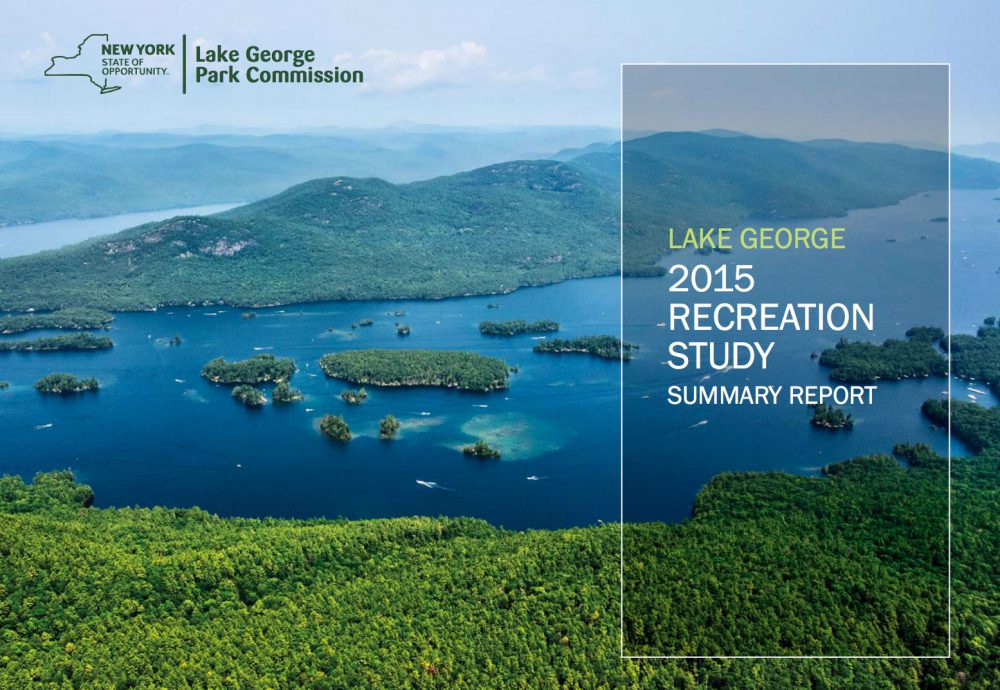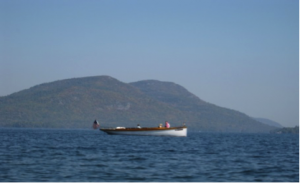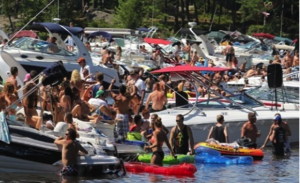
A Q&A with Tracey Clothier
All it takes is one afternoon on the water, atop a mountain, or hanging your feet off a dock to see why Lake George is one of the most treasured bodies of water in the country. With one-of-a-kind views, amenities and activities of all kinds, it’s easy to imagine why this popular destination attracts tens of thousands of people every year.
To stay abreast of how the lake is evolving with the times, the Lake George Park Commission (LGPC), in partnership with the Lake George Association, brought on The LA Group and Siena Research Institute to conduct a comprehensive recreation study.
Initiated as a 10-year check-in from a previous study done in 2005, the 2015 study provides a snapshot in time and an analysis of current recreational boating and general use trends on the lake.
With the final report unveiled this summer, we take a behind the scenes tour with one of the leading members of the project, The LA Group’s Tracey Clothier, senior planner, AICP CEP. From Tracey, we learn what it takes to bring a project like this together and how this kind of research can benefit similar recreational areas.
Q: In your opinion, what is the biggest takeaway from the Recreation Study?
A: Above all, it’s that visitors, residents, and businesses continue to recreate on Lake George with a high level of enjoyment. People still love our lake! We also learned a lot about evolving trends in permit applications, the types of recreation on the lake, and how people are congregating in various locations. While the details are invaluable for the LGPC and all those with a vested interest in the lake, the major story remains that we still have a beloved destination.
Q: How did you become involved in this project?
A: The LA Group had previously established a relationship with the LGPC after working on the 2013 Lake George Aquatic Invasive Species Prevention Plan/GEIS. From this, we learned about an RFP to work on the 2015 Lake George Recreation Study. In our response, we demonstrated that our staff has many years of personal and professional experience on the lake, allowing us to jump in efficiently and effectively with no learning curve.
I was also personally passionate about being a part of the project because I’ve spent much of my life enjoying the amazing experiences Lake George provides. It was a great opportunity to be a part of something that might make a contribution to the future of something so special.
Q: What was the goal of this research study? What were you hoping to find?
A: The primary goal of the study was to ascertain whether recreational conditions have changed since they were measured in 2005. In the process, we hoped to provide a current snapshot of activity and determine trends based on changes over the past 10 years.
Specifically, the questions we posed were:
- What are the current on-lake recreation conditions?
- What are trends in water-based recreation?
- Are residents/visitors satisfied with their experience?
- How have conditions, trends, and perceptions changed in 10 years?
In producing the report, we hoped the information would become a guide for regional decision makers as they look at recreational use and public safety efforts on and around Lake George. We also made a concerted effort to translate the information into an easy-to-read format for the casual reader so they too can use it as a resource for their short and long-term planning.
Q: What types of studies did you conduct in order to answer your questions?
A: The overall project was broke into three studies: inventory and data analysis, a public perception survey, and a surface assessment study.
For the first part, The LA Group inventoried marina usage, boat launches, and commercial operations such as parasailing, tour boats, and boat taxis. We also used data from the past 10 years to assess if economic conditions were influencing the number of boat registrations and dock permits. We also wanted to know if the LGPC was effectively and efficiently distributing its Marine Patrol and enforcement efforts on the lake.
The Perception Survey made up the second phase of research and was developed by the Siena Research Institute at Siena College to investigate two questions:
- Are residents and visitors satisfied with their recreational experience?
- Has this opinion changed over the last ten years?
Lastly, The LA Group conducted a Lake Surface Use Assessment to review Lake George’s overall capacity and ability to support changing boating activities. Put simply, we counted how many boats were on the lake on a peak summer day. Using helicopter fly-overs and on-the-lake reports from volunteers, we were able to create a snapshot of conditions so we could answer:
- What are the overall peak boat counts throughout the lake?
- How do they compare to counts conducted in 2005?
Q. What were your general findings for the Perception Survey?
A. The survey found that even though people are generally very pleased with their overall experience on Lake George, the factors that can be controlled, such as safety and crowding, show some growing concerns. It is important for the Lake George Park Commission to continually monitor marina and boating trends on the lake so that it can provide effectively for both public safety and help ensure that Lake George is as treasured by future generations as it is today.
Q. You mentioned volunteers. How did they support the research efforts?
A: As part of the Lake Surface Assessment, The LA Group recruited 16 volunteers from multiple regions of the lake. Using our research and documentation process, they helped count the number of boats in specific zones on peak days. The volunteers also helped report the types of boats and the activities people were participating in such as tubing, fishing, cruising, etc. With participation from local volunteers, we expanded the buy-in and engagement with the ongoing research and final report.
Q: What other services and activities did The LA Group provide to support this project?
A: While we oversaw or conducted many of the specific research steps, it’s important to note that we also acted as public advocates and educators for the many municipalities, organizations, and media interested in this high-profile project. From formal presentations to private board meetings, email marketing, advertising, and even putting feet on the ground to hand out fliers at tourist venues, marinas, and more – we spread the word and gained public support for the project.
Public participation not only helped promote the efforts overall, but it actually enhanced the research itself. With buy-in from the community, we were able to increase participation, ensuring all perspectives were taken into account in the various analyses and research methods.
Q: You mentioned that the report tells a ‘tale of two lakes’. What does that mean?
A: Lake George is unique in that it offers something for everyone. It’s beloved by people who value quiet solitude and those that want social fun and entertainment.
For example, it was fascinating to find that the north and middle area of the lake are often quiet because almost 65% of boating traffic is concentrated in the southern portion. While this can be easily explained based on the location of the Town of Lake George and the number of boat launches and tourist attractions in that area – the differentiation is important. With “two lakes”, we had to consider our research results across the whole lake, as well as how they fit within specific locations. Because changing capacity and the mix of activities could eventually create public safety or pollution concerns.

Solitude off Dome Island

Log Bay Day off Shelving Rock
Q: How will this information help future planning in Lake George?
A: Knowing what’s present today will help residents, businesses, and municipalities understand how future changes could impact the lake experience. Some specific ideas presented in the report were:
- With the increase in dock permit applications and the upward trend in boat registration, there is the potential for increased pressure on Lake George and its resources.
- An improving economy and lower gas prices could potentially result in more boats on the lake.
- The potential increase in future new docks may also significantly increase the number of new boats.
- The trend of wider boat beams and the shift of increased numbers of rental boat applications is already impacting the rising applications for marina expansions.
- The displacement of dock rental slips for boat rentals may result in an increase in the demand for Class B marinas.
- The growing diversity of recreation on the lake will require more careful consideration of boat density and safety on the lake.
Q: Do you think research efforts like this could be beneficial for other areas?
A: We know very well that every unique place has its own unique opportunities, challenges, influences, and more. Lake George is no exception and I know other lakes, parks, campuses, or other recreation areas would as well. However, regardless of what makes them different, the goal of protecting positive experiences remains universal. With strategic research and outreach comes awareness; and from there, efforts like this are why visitors will continue to have life-long memories in some of our most treasured places.
Visit The LA Group’s Community and Regional Planning Portfolio


